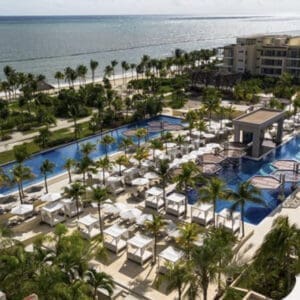Over the course of the last decade, The Ritz-Carlton Hotel Company has opened the doors to more than 50 new, renovated or refurbished luxury hotels in its growing global portfolio. Properties in Tianjin and Macau brought the luxury brand’s number of hotels in China to eleven; the Ritz-Carlton hotels in Almaty, Herzliya and Bangalore marked the brand’s entry into Israel, Kazakhstan and India; and the barefoot luxury experiences in Dorado Beach and Bali were milestones in casually chic and elegant design execution, driven by extensive global customer research.

Since 2004, The Ritz-Carlton design team has produced specifications for one individually designed and curated hotel after the next. High-style and contemporary design exudes in Kyoto, Wolfsburg and Barcelona. Tasteful conversions of spectacular former palaces in Vienna, Muscat and Riyadh, and transformations of protected buildings in Philadelphia, San Francisco and Georgetown near Washington DC brought in a new era of converted and preserved heritage spaces.
As The Ritz-Carlton embarks upon the development of an additional 30 hotels within the next three years, the brand’s design philosophy has evolved to now represent a diverse and varied collection of beautiful local and culturally relevant hotel and resort environments.
“Each new project gives us an opportunity to create the best hotel within its locale that provides a true sense of place. Consideration is given to the market needs and how we can best create a hotel that will be a signature property within the group”, said Herve Humler, President and Chief Operations Officer, The Ritz-Carlton Hotel Company, L.L.C.
According to Humler, while most new builds tend to be more contemporary with modern interpretations of elegance, two recent hotel openings are in total contrast. “The Ritz-Carlton Abu Dhabi, Grand Canal is classical in design. The hotel is situated adjacent to the statuesque Sheikh Zayed Grand Mosque, so the façade and interiors have been designed to respect and complement the area. Inspired by 15th to early 17th century Renaissance architecture and the urban planning of the city of Venice, the hotel is located at the waterfront and consists of ten stately buildings arranged in a crescent formation.”
Conversely, Dorado Beach, a Ritz-Carlton Reserve (above) is located on the island of Puerto Rico. The resort is an intimate retreat offering a true sense of barefoot elegance, blending Laurance Rockefeller’s novel environmental design philosophies and modern yet minimal décor. Created as an open-air enclave, infused with references to the surrounding natural landscape and diverse culture, the power of the great outdoors weaves its magic on interior comfort.
Drawing on themes of local relevance, The Ritz-Carlton adopts design strategies to enhance the brand image in an increasingly global marketplace. The company philosophy is to design hotels that are casually elegant, with the occasional classical influence as appropriate. Where there are multiple hotels in one city, the preference is to provide diverse physical products and contrasting styles.
“Our company design standards are the blueprint from which we establish engineering infrastructure, operational requirements, safety regulations and room sizes — however they do not drive the character of a hotel. We do not work to one design mold, but rather allow the process to be destination and customer focused as we grow into many new international locations.”
Lodging by design
Each Ritz-Carlton property around the world personifies unique design befitting of its location. Examples include:
In the newly opened Ritz-Carlton resort in Kyoto, Japan, all views are of the river and the Higashiyama Mountains. The architects and designers have retained the character and aesthetic of a traditional Meiji house and courtyard into the architectural structure of the building. The interiors created by Peter Remedios and Spin Studios pay homage to the traditions of Japan, with patterned motifs created by local artisans and the incorporation of Zen rock gardens (karesansui) and water features, including a four-story waterfall are aesthetically positioned in the heart of the hotel.
Phulay Bay, a Ritz-Carlton Reserve is nestled on the shore of the Andaman Sea, the ultra-exclusive resort is the vision of Thai architect Lek Bunnag. It features modern styling and architecture with accents of Thai culture and design to create a harmonious synergy of luxury and tradition to complement its secluded location. Bunnag draws strongly from Thai traditions and cultural heritage to create an environment where relaxation and enjoyment are the very bedrock of the guest experience.
The stylish and contemporary interiors of The Ritz-Carlton, Hong Kong, which set the scene for this thoroughly modern hotel set in the heart of Hong Kong, are by Singapore’s LTW. The sense of arrival is breathtaking with views of Victoria Harbor and the iconic island’s skyline as the backdrop. Guests are welcomed into the highest hotel in the world on the 9th floor, before being transported up to the hotel lobby on the 103rd floor where panoramic views await them — and potentially journeying further to the top of the hotel on floor 118.
The Ritz-Carlton, Dove Mountain was inspired by the lush Sonoran Desert surroundings. The Arizona resort was created with an authentic sense of place with the presence of desert stone and metal. This celebration of Arizona’s geology can be seen in the resort’s natural quartzite floors, raw steel fixtures, copper accents, and historical desert artifacts, such as colorful geodes and quartz crystal. Interior carpets represent Arizona sunrises and sunsets, each bordered by the area’s majestic saguaro cactus. The strikingly beautiful saguaro grows nowhere else in the world, and the main building of the resort was actually relocated early in the construction process, in order to preserve two decades-old saguaro cacti which were growing near the foundation. Contributing to the design were HKS Hill Glazier Studios, Wilson and Associates and EDG Interior Architecture.
The Ritz-Carlton New York, Central Park was designed by Frank Nicholson. This Manhattan property features views across Central Park, bold contemporary artworks, an eclectic mix of modern and regency furniture and stunning floral arrangements. The overall effect is one of relaxed sophistication.
The Ritz-Carlton, Bachelor Gulch in Beaver Creek, Colorado is another resort that showcases design relevance through the use of beautiful natural materials, by embracing the rich heritage of ‘parkitecture’ — a style inspired by the great mountain lodges in North America. Designed by Wilson and Associates and recently enhanced by Bilkey Llinas, large rustic pine beams, intricate stonework, detailed millwork, sophisticated furnishings, contemporary paintings and a welcoming grand fireplace are harmonious with the mountainous surroundings.
According to Barrie, designers of the Hotel Arts in Barcelona have captured the city’s strong emphasis on the arts and culture. Skidmore, Owing and Merrill architect Bruce Graham encased the 44-story Hotel Arts tower in steel and tinted glass. The interiors of the tower, which were recently renovated by Barcelona’s CGA, feature elegant combinations of classical wood, modern steel and contemporary furnishings, all framed by views of the city and the Mediterranean.
Sharq Village & Spa, Doha in Qatar celebrates the rich cultural legacy of Qatari history by offering an insight in the vibrant life of the past. The oceanfront resort has been recreated to reflect the architecture, designs and experiences of a generations-old Qatari community. It tells Arabian tales of the merchants, pearl divers and captains that hauled their heavy boats ashore to infuse this Middle Eastern land with prosperity. Like the communities of the past, Sharq Village & Spa springs organically from the centre of the busy ancient bazaar and begins a gentle evolution of courtyard houses, crooked alleyways, cooling pools, elegant palaces and thriving fish market down to the palm-fringed coastline.
The opulent yet contemporary style of The Ritz-Carlton Beijing, Financial Street makes the hot list. Coupled with an assorted mélange of furniture, unique aspects of the downtown hotel include the hanging calligraphy brushes, paintings, luxurious fabrics, brocades and Chinese wall silks. The use of bold, yet cleverly integrated colors is aesthetically pleasing and is the vision of interior designers Hirsch Bedner Associates who placed close attention to the art of Feng Shui.
Tverskaya 3: the exclusive address of The Ritz-Carlton, Moscow located adjacent to Red Square had the interiors designed by Peter Silling. An historic hospitality address for centuries, the building is the site of the 334-room hotel featuring an imperial Russian façade and chic, elegant interior with unique contemporary accents.
And the iconic property which guarantees the best location in its city is the sleek Ritz-Carlton, Tokyo. Architecturally this hotel is an icon of cosmopolitan sophistication, rising to a height of 800 feet. This leviathan of chrome and glass is in a commandeering position, surrounded on all sides by sweeping views of the city and Mount Fuji.
Today’s sophisticated and trend-conscious hotel guests take pleasure from savoring the very latest discoveries ahead of the crowd — in hotels just as much as in the worlds of art and fashion. Quite apart from their design attributes’, hotels of today also have to fulfill two key requirements. As temporary homes of business travelers they must function effectively as workplaces; and they must offer a wide range of relaxation possibilities for the discerning leisure traveler. Recognition of this is evident in The Ritz-Carlton hotels around the globe. And yet, even with success in these areas, the hotel company continues to assess the design enhancements required in its existing portfolio, and as a result, investment to continuously better a guests experience runs into the millions.















